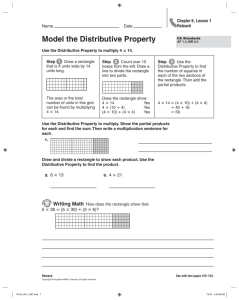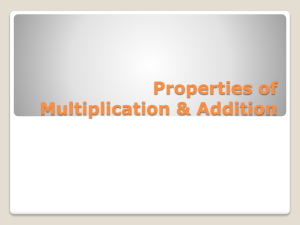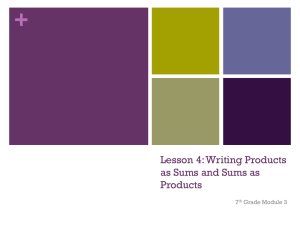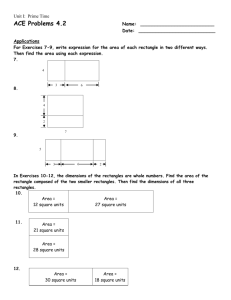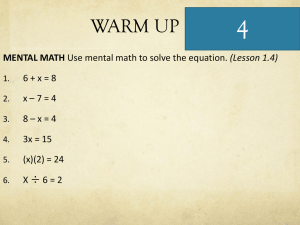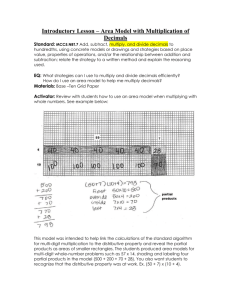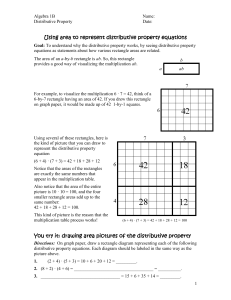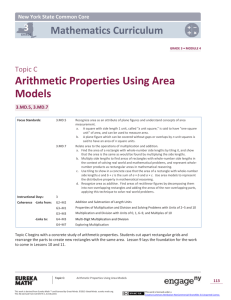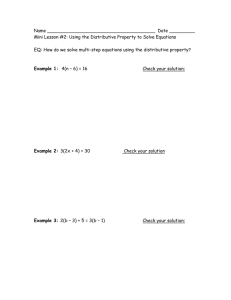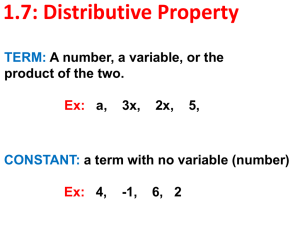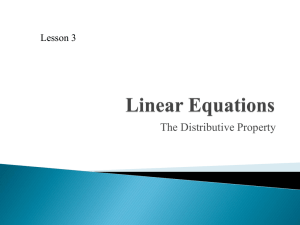2.3.4
advertisement
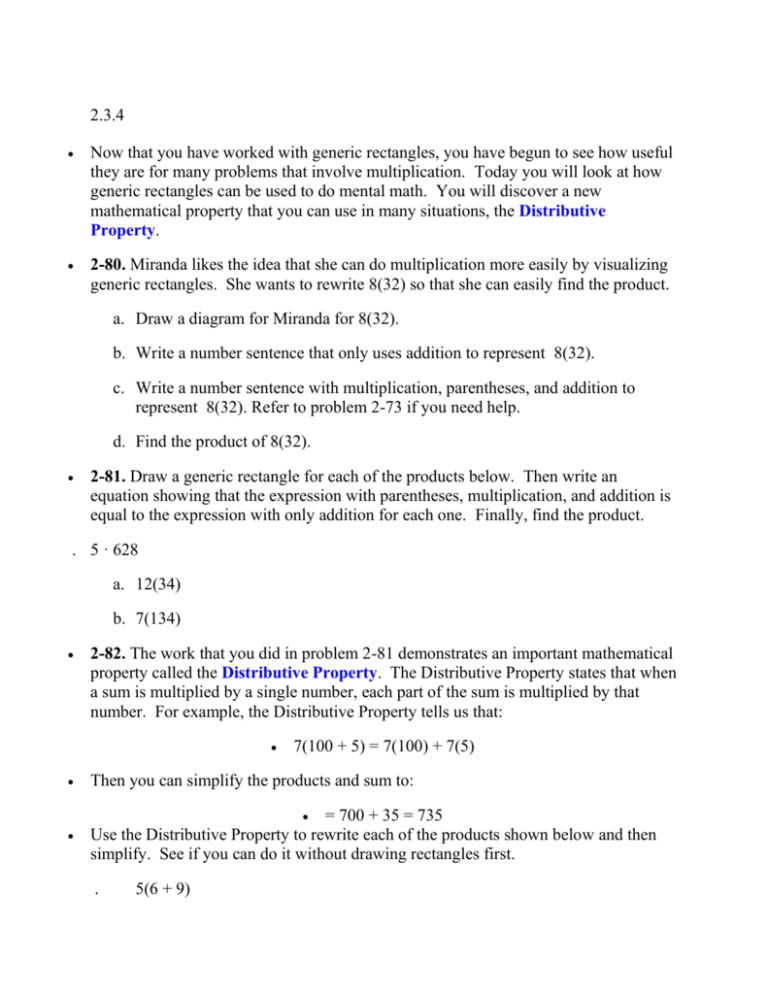
2.3.4 Now that you have worked with generic rectangles, you have begun to see how useful they are for many problems that involve multiplication. Today you will look at how generic rectangles can be used to do mental math. You will discover a new mathematical property that you can use in many situations, the Distributive Property. 2-80. Miranda likes the idea that she can do multiplication more easily by visualizing generic rectangles. She wants to rewrite 8(32) so that she can easily find the product. a. Draw a diagram for Miranda for 8(32). b. Write a number sentence that only uses addition to represent 8(32). c. Write a number sentence with multiplication, parentheses, and addition to represent 8(32). Refer to problem 2-73 if you need help. d. Find the product of 8(32). 2-81. Draw a generic rectangle for each of the products below. Then write an equation showing that the expression with parentheses, multiplication, and addition is equal to the expression with only addition for each one. Finally, find the product. . 5 · 628 a. 12(34) b. 7(134) 2-82. The work that you did in problem 2-81 demonstrates an important mathematical property called the Distributive Property. The Distributive Property states that when a sum is multiplied by a single number, each part of the sum is multiplied by that number. For example, the Distributive Property tells us that: 7(100 + 5) = 7(100) + 7(5) Then you can simplify the products and sum to: = 700 + 35 = 735 Use the Distributive Property to rewrite each of the products shown below and then simplify. See if you can do it without drawing rectangles first. . 5(6 + 9) a. 11(2 + 5) b. 4 · 512 2-83. Richard wants to multiply 67 · 53 and decided to use a generic rectangle. He drew the diagram shown at right. “Hey,” Richard said while looking at his generic rectangle, “It’s kind of like a double Distributive Property: (50 + 3) (60 + 7). I can use the Distributive Property twice, once on the top half of the rectangle and once on the bottom half.” . Discuss Richard’s idea with your team. How can you see the Distributive Property in the top and bottom halves of the rectangle? a. Apply Richard’s idea by setting up two numerical expressions using the Distributive Property, one for each half of the rectangle. Then calculate the product of 53(67) by evaluating each expression. 2-84. Additional Challenge: Calculate the following products without using a calculator. Use the method of your choice, but see if you can do it efficiently or even mentally. Check your answers with your team for accuracy. . 15(38) a. 92 · 156 b. 101(34 + 62) c. 525(18) Distributive Property The Distributive Property states that the multiplier of a sum or difference can be “distributed” to multiply each term. For example, to multiply 8(24), written as 8(20 + 4), you can usethe generic-rectangle model at right. The product is found by 8(20) + 8(4). So 8(20 + 4) = 8(20) + 8(4) You will work more with and formalize the Distributive Property in Chapter 7. 2-86. Look at the generic rectangle at right. Homework Help ✎ a. What two numbers are being multiplied using this rectangle? How can you tell? b. Write the product as a sum of the areas and find the answer. c. Use the Distributive Property to write an equation showing that the product is equal to an expression with parentheses, multiplication, and addition. 2-87. In Section 2.1, you learned how to create dot plots, bar graphs, histograms, and stem-and-leaf plots. Which of these representations would best display the data given below? Use that representation to display the data. Homework Help ✎ Boot sizes of the Math Marching Team: 10, 8, 12, 10, 10, 9, 10, 11, 12, 8, 8, 9, 10, 11, 10, 9, 11, 11, 12, 11, 10, 11, 8, 10, 12, 8 2-88. The following number lines are missing some numbers. Sketch each one on your paper and use the information provided to complete the number lines. Homework Help ✎ . a. b. c. 2-89. For each of the following problems, complete the fraction on the right so that the fractions are equal. Be sure to show your work clearly. Homework Help ✎ . a. b. 2-90. This problem is a checkpoint for addition and subtraction of decimals. It will be referred to as Checkpoint 2. Add or subtract the following decimals. Homework Help ✎ . 2.95 + 18.3 + 11 a. 9.2 − 0.375 b. 0.275 + 27.5 c. 90 − 0.903 Check your answers by referring to the Checkpoint 2 materials. If you needed help solving these problems correctly, then you need more practice. Review the Checkpoint 2 materials and try the practice problems. Also consider getting help outside of class time. From this point on, you will be expected to do problems like this one quickly and easily.
